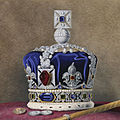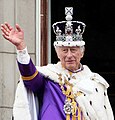Imperial State Crown
| Imperial State Crown | |
|---|---|
The Imperial State Crown is one of the
State Openings of Parliament. The crown is adorned with 3,170 precious stones, including the Cullinan II diamond, St Edward's Sapphire, the Stuart Sapphire, and the Black Prince's Ruby (a spinel
).
History
Origin
fleurs-de-lis, but without arches (an open crown), was a king's usual headgear at state occasions until the time of Henry V, who is depicted wearing an imperial crown of state with gold arches (a closed crown).[3] Arches were a symbol of sovereignty, and by this point in history, the king of England was being celebrated as rex in regno suo est imperator – an emperor of his own domain – subservient to no one but God, unlike some continental rulers, who owed fealty to more powerful kings or to the Holy Roman Emperor.[4]
St George.[6] The crown weighed 2.8 kg (7 lb 6 oz troy) and was set with 168 pearls, 58 rubies, 28 diamonds, 19 sapphires, and 2 emeralds.[7][8]
Following the abolition of the monarchy and the execution of
Restoration to present day
The Wilton Diptych[10]
Upon the
rose-cut and 147 table-cut diamonds, 277 pearls, 17 sapphires (including St Edward's Sapphire, thought to have been taken from the Confessor's ring when his body was reinterred at Westminster Abbey in 1163), 11 emeralds, 4 rubies, and the Black Prince's Ruby (a cabochon red spinel).[12]
At the State Opening of Parliament in 1845, the
Cullinan II diamond, also known as the Second Star of Africa.[14] A faithful copy of the Victorian crown, which had fallen into a poor state of repair, was made in 1937 by the jewellers Garrard & Co. for George VI.[15] (The empty frame of Victoria's crown survives in the Royal Collection, its monde and cross now sit on the current crown)[16] The Imperial State Crown's inner headband was adjusted and its arches lowered by 1 in (2.5 cm) in 1953 for Queen Elizabeth II.[17]
Description
| External videos | |
|---|---|
The Imperial State Crown is 31.5 cm (12.4 in) tall and weighs 1.06 kg (2.3 lb), and has four fleurs-de-lis alternating with four crosses pattée, supporting two arches topped by a monde and cross pattée. Its purple velvet cap is trimmed with ermine. The frame is made of gold, silver and platinum, and decorated with 2,868 diamonds, 269 pearls, 17 sapphires, 11 emeralds, and 5 rubies.[18]
Notable stones are
Elizabeth I, but this association is almost certainly erroneous.[20]
Usage
The crown is worn by the monarch on leaving Westminster Abbey at the end of his or her
State Diadem, while the Imperial State Crown was carried beside her.[22] Usually, it is taken to the Palace of Westminster under armed guard in its own carriage and placed in the Robing Room, where the monarch dons the Robe of State and puts on the crown before giving the speech to Parliament. If a State Opening occurs before a coronation, the crown is placed on a cushion beside the monarch. In 1689, one week after being proclaimed king, William III wore his crown in Parliament to pass the Crown and Parliament Recognition Act 1689.[23] When not in use, the Imperial State Crown is on public display in the Jewel House at the Tower of London
.
Gallery
-
Queen Victoria's crown made in 1838
-
George V wearing the pre-1937 crown in 1911 in his coronation portrait
-
Elizabeth II wearing the Imperial State Crown in 1953
-
The crown on Elizabeth II's coffin, with the Sovereign's Sceptre and Orb during her state funeral in September 2022
-
Charles III wearing the crown in 2023 at his coronation
See also
References
- ^ "Crown Jewels". Parliamentary Debates (Hansard). Vol. 211. United Kingdom: House of Commons. 16 July 1992. col. 944W.
- ^ Hoak, p. 59.
- ISBN 978-1-134-64159-8.
- ^ Hoak, pp. 55, 63.
- ^ Twining, Edward Francis (1960). A History of the Crown Jewels of Europe. Batsford. p. 139.
- ISBN 978-0-300-07992-0.
- ^ a b Collins, Arthur Jefferies (1955). Jewels and Plate of Queen Elizabeth I: The inventory of 1574. Trustees of the British Museum. p. 266.
- ISBN 095023740X.
- ^ "The King, the Crown, and the Colonel". The National Archives of the United Kingdom.
- ^ Keay, p. 126.
- ^ Mears; Thurley; Murphy, p. 29.
- ^ Tennant, Prof. (14 December 1861). "Queen Victoria's crown". Scientific American. 5 (24): 375.
- ^ "Crown jewels factsheet" (PDF). Historic Royal Palaces Agency. Retrieved 9 December 2015.
- ^ Mears, et al., p. 30.
- ^ Keay (2011), pp. 174–175.
- Royal Collection Trust(rct.uk).
- ISBN 978-0-500-51575-4.
- Royal Collection Trust. Inventory no. 31701.
- ^ Mears; Thurley; Murphy, p. 30.
- ISBN 978-1-873993-13-2..
- ^ The Royal Household. "The Royal Collection: The Crown Jewels". The Official Website of the British Monarchy. Archived from the original on 8 October 2015.
- ^ Shearing, Hazel (14 October 2019). "Queen's Speech: Why didn't the Queen wear her crown?". BBC News. Retrieved 15 October 2019.
- ^ Twining, p. 173.
Bibliography
- Kenneth J. Mears; Simon Thurley; Claire Murphy (1994). The Crown Jewels. Historic Royal Palaces. ASIN B000HHY1ZQ.
- Dale Hoak (2002). Tudor Political Culture. Cambridge University Press. ISBN 978-0-521-52014-0.
External links
- "The Imperial State Crown". Royal Collection Trust. Inventory no. 31701.
- "Frame of Queen Victoria's Imperial State Crown". Royal Collection Trust. Inventory no. 75002.
- The Crown Jewels at the Royal Family website







